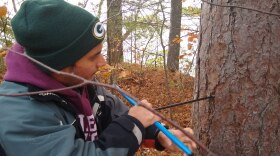For Northwoods artists Mary Burns and Debbie Jircik, creating art is sometimes more than putting paint on canvas or throwing clay to be fired.
Instead, it’s pulling on waterproof boots, slogging into Northwoods bogs, and collecting large pails of water.

“We didn’t see anyone doing any of this kind of work, where they were actually going out in the field, collecting water from bogs and lakes, and comparing how…that affects those dyes,” Burns said.
Burns is from Mercer, and Jircik is from Eagle River.
They’re both participants in the world of using natural dyes on fabric.
“It gives me joy, that connecting through the natural world, through the plant world, especially,” Jircik said
Each was selected as an Artist in Residence at the UW-Madison Trout Lake research station in Boulder Junction for 2019. Together, they worked to form an even stronger connection between art and science through a unique dye project.
“Different art forms require different exploration, and this is more, seems like the link between science and art is much more direct and concrete and people can see it,” Jircik said.
The visuals are striking.

The pair dyed silk and wool with natural ingredients to make a rainbow of colors. Different samples were produced with identical processes and dyes, with the exception of the water.
The water came from local bogs, local lakes, and Lake Mendota in Madison, and all else being equal, just a change in the water often led to arresting arrays of color.
“We were hopping up and down,” Burns said. “We were very excited.”
In her Mercer studio, Burns showed a cochineal-and-lime-juice dye with water from Trout Bog in Vilas County. The fabric turned a reddish-brown.
With Lake Mendota water, it transformed into a bright pink or orange hue.

“We didn’t have any idea how the different water sources were going to affect that. That was the exciting part about the experiment,” Burns said.
Burns and Jircik figure factors like hard or soft water, acidity, and surrounding rock and soil composition make the difference.
Their findings in waters, dyes, and colors make them pioneers of sorts.
“It’s a huge area of study that hasn’t been done much,” said Burns.
“We are seeing a physical manifestation of what water does, all these different waters,” Jircik added. “They aren’t the same.”
Jircik notes many of the plants used for natural dyes have long been known to have medicinal qualities, as well. For her, it’s just another example of the splendor of the natural world.
“Wow, there’s this wealth of plants that are around us that give us so much. It’s kind of a way to acknowledge, wow, how much nature provides for us,” she said. “It’s pretty incredible.”

Burns and Jircik suspect their discoveries might be providing just a part of the water-and-dye spectrum. They’d love to do more experiments with more water sources across Wisconsin and the Midwest, using water as a connection between science and art, between color and location.
“It’s another way of getting to know a place, is getting to know our water and having an appreciation for it,” Jircik said.






